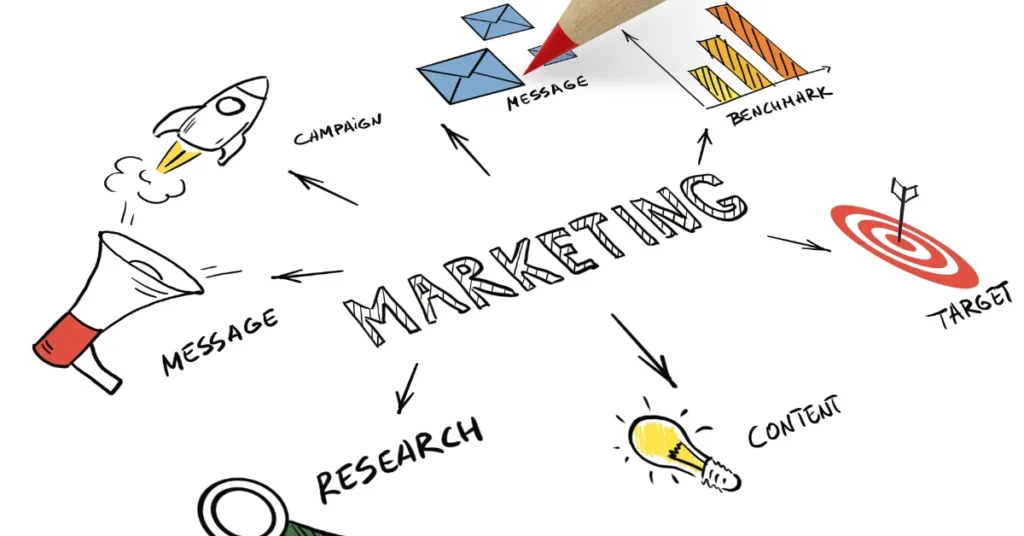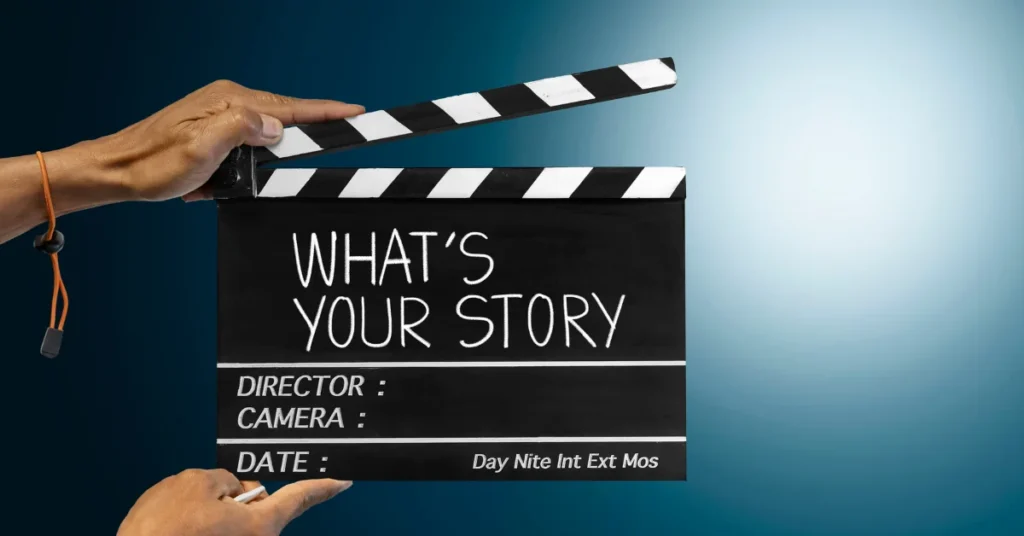Have you ever noticed how a good story can captivate you? Whether it’s a gripping novel, a heartfelt movie, or even a well-told anecdote from a friend, stories have a unique power to hold our attention and make us feel connected. In the world of content marketing, this same magic can transform the way brands engage with their audience.
In today’s fast-paced digital landscape, where users are constantly bombarded with information, storytelling in content marketing has become a crucial tool for marketers. It’s no longer enough to simply showcase a product or service; brands need to build a narrative that resonates with their audience on a deeper level. By crafting compelling stories, marketers can create emotional connections, inspire trust, and ultimately drive action.
So, how can you use storytelling to make your content marketing efforts more impactful? Let’s dive into the art of storytelling and discover how you can create stories that truly resonate with your audience.
The Power of Storytelling in Marketing: Why It Works
Storytelling is as old as humanity itself. From cave paintings to digital narratives, stories have always been a fundamental way for people to share experiences, pass down knowledge, and connect emotionally. But why are stories so powerful in marketing?

1. Stories Create Emotional Connections
Think about the last time you watched a touching advertisement or read a moving article. Chances are, you remember how it made you feel more than the specific details. That’s because stories engage the emotional side of our brains, making us feel empathy, excitement, joy, or even sadness. When a brand tells a story that resonates emotionally, it creates a lasting impression that goes beyond mere facts and figures.
For example, consider how a fitness brand might share a customer’s journey of overcoming obstacles to achieve a healthier lifestyle. This narrative not only highlights the benefits of the product but also inspires and connects with the audience on an emotional level.
2. Stories Make Information Memorable
Humans are wired to remember stories more than abstract concepts or isolated data points. A well-told story provides context, structure, and meaning, making information easier to recall. This is why brands that use storytelling in their content marketing often see higher engagement rates. When you weave a story into your content, your audience is more likely to remember your message—and your brand—long after they’ve clicked away.
Consider a company like Apple, which doesn’t just sell products but tells stories of innovation, creativity, and empowerment. By consistently framing its marketing around these narratives, Apple has become more than just a tech company; it’s a symbol of cutting-edge technology and bold innovation.
3. Stories Drive Action
At its core, storytelling in marketing isn’t just about engaging the audience; it’s about inspiring them to take action. A compelling story can motivate customers to buy a product, sign up for a service, or share content with friends. This is because stories help people see themselves in a particular scenario or outcome, creating a sense of urgency or desire to act.
For instance, when a brand tells a story of a customer’s transformation—how they went from struggling with a problem to finding success with the brand’s solution—it shows potential customers the value of taking that same journey.
4. Stories Differentiate Your Brand
In a crowded marketplace, it’s easy for brands to get lost in the noise. A unique story can help your brand stand out by highlighting what makes you different. Whether it’s your origin story, your values, or your mission, storytelling can showcase your brand’s personality and make it memorable in a sea of competitors.
Patagonia is a great example of a brand that uses storytelling to set itself apart. By sharing stories about environmental activism and ethical business practices, Patagonia has built a strong brand identity that resonates with a specific audience.
Key Elements of a Compelling Story for Content Marketing
Crafting a captivating story isn’t just about stringing words together—it’s about weaving elements that create a meaningful and engaging narrative. Let’s break down the key components that make a story resonate with an audience, especially in the context of content marketing.

1. Characters
Every great story starts with compelling characters. In content marketing, your characters could be your customers, employees, or even your brand itself. Characters are the heart of the story; they’re what the audience connects with on a human level. People relate to people, not just products or services, so showcasing real experiences, emotions, and journeys through your characters is essential.
For example, a skincare brand might tell the story of a customer struggling with acne who, through perseverance and the right product, gains confidence and clearer skin. This character’s journey becomes relatable and inspiring, making the audience feel invested in their story.
2. Conflict
Without conflict, there is no story. Conflict is the challenge or problem that the character faces, and it’s a crucial element that drives the narrative forward. In the context of marketing, conflict often reflects the pain points or challenges that your audience might be experiencing. It’s what makes your story relatable and sets the stage for your product or service as the solution.
For instance, a software company might highlight the frustrations a team faces with outdated technology—missed deadlines, lost data, and countless hours wasted. This conflict sets up the narrative for introducing their cutting-edge solution that addresses all these problems.
3. Resolution
The resolution is the part of the story where the conflict is resolved, and the characters achieve their goals. This element is vital because it demonstrates the value of your product or service and shows how it can help the audience overcome their challenges. A strong resolution ties back to the initial conflict and reinforces your brand’s promise.
For example, following the skincare story, the resolution could show the customer feeling confident and happy with their clear skin, thanks to the product. This not only provides closure to the story but also reinforces the effectiveness of the brand.
4. Authenticity
Authenticity is what makes a story believable and relatable. In today’s digital age, audiences are quick to spot inauthenticity, and it can significantly damage your brand’s reputation. Authentic storytelling is about being honest and transparent, showing real experiences, and being true to your brand values.
Consider the example of TOMS Shoes, which built its brand around the authentic story of social responsibility—donating a pair of shoes to a child in need for every pair purchased. This genuine commitment to social good resonates deeply with customers and has been a key driver of TOMS’ brand loyalty.
5. Call to Action (CTA)
Every effective marketing story needs a clear call to action. Once you’ve engaged your audience with a compelling narrative, it’s important to guide them toward the next step, whether it’s making a purchase, signing up for a newsletter, or sharing your content. Your CTA should feel like a natural extension of the story, aligned with the emotions and motivations you’ve evoked.
For example, after telling a story about a customer’s success using a product, a CTA might invite the audience to “start your journey today” or “find your solution now,” creating a seamless transition from narrative to action.
How to Identify Your Brand’s Unique Story
Finding your brand’s unique story is the foundation for effective storytelling in content marketing. It’s not just about what you sell but about why you exist, what you stand for, and how you connect with your audience. Here’s a step-by-step guide to uncovering and defining your brand’s story.

1. Understand Your Brand’s Values and Mission
Your brand’s values and mission are the cornerstones of your story. Start by reflecting on the purpose behind your business. Ask yourself questions like:
- Why did we start this company?
- What core beliefs drive our business decisions?
- What do we hope to achieve for our customers and the community?
By answering these questions, you begin to shape a narrative that goes beyond products or services. It’s about creating a story that aligns with your brand’s deeper purpose.
For example, Dove’s mission goes beyond selling soap and beauty products. Their “Real Beauty” campaign is rooted in promoting self-esteem and redefining beauty standards, which resonates with their audience on an emotional level.
2. Know Your Audience
A story that resonates starts with understanding who you’re telling it to. Take the time to research and understand your audience’s needs, preferences, and challenges. Create detailed audience personas that include demographic information, interests, and pain points. This helps ensure your story speaks directly to them.
Think about what your audience cares about and what they’re looking for in a brand. Are they seeking a company that shares their values, solves their problems, or inspires them? The more you know about your audience, the more relevant and compelling your story will be.
3. Highlight Your Unique Selling Proposition (USP)
Your Unique Selling Proposition (USP) is what sets you apart from the competition. It’s the unique benefit or characteristic that makes your brand stand out. Your story should highlight this uniqueness, weaving it into the narrative in a way that feels natural and compelling.
For instance, if your brand offers the fastest delivery in your industry, your story could center around the value of time, showcasing how your service helps customers get what they need quickly, allowing them to focus on what matters most.
4. Share Your Brand’s Origin Story
Every brand has an origin story, and sharing yours can humanize your brand and create a strong connection with your audience. Think about how your business started. Was it born out of a passion for solving a specific problem? Was there a defining moment or challenge that shaped your brand’s journey?
Sharing these stories helps your audience understand the heart of your brand and why you do what you do. This authenticity fosters trust and loyalty.
Take the example of Ben & Jerry’s. Their origin story is not just about ice cream but about two friends who wanted to create a company with a strong commitment to social and environmental responsibility. This story is integral to their brand identity and resonates with customers who value these principles.
5. Leverage Customer Stories
Sometimes the best stories are told by your customers. Highlighting customer testimonials, case studies, or user-generated content can provide authentic and relatable narratives that showcase your brand’s impact.
Encourage your customers to share their stories about how your product or service has made a difference in their lives. These stories add a layer of authenticity and provide social proof that can be incredibly persuasive.
Airbnb, for example, uses customer stories extensively in its marketing. They share experiences from both hosts and guests, painting a picture of unique travel experiences that only Airbnb can provide.
6. Stay True to Your Brand Voice
Finally, your story should be told in your brand’s unique voice. Whether your tone is formal, casual, humorous, or inspirational, consistency in your messaging helps build a recognizable brand. Your brand voice should reflect your company’s personality and values, making your story feel genuine and aligned with your overall brand identity.
Techniques for Crafting Engaging Narratives
Crafting an engaging narrative is an art form that combines creativity with strategic thinking. To captivate your audience and make your content memorable, you need to use storytelling techniques that bring your brand’s story to life. Here are some proven techniques for crafting compelling narratives that resonate with your audience:

1. The Hero’s Journey
One of the most classic storytelling techniques, the hero’s journey, is a narrative framework that takes a character from the ordinary world into a journey of discovery, challenge, and transformation. In content marketing, your customer can be the hero, your product or service the guide, and the journey is their path to overcoming a challenge or achieving a goal.
How to Use It:
- Start by identifying the “hero” of your story—usually, this is your target customer.
- Outline the “journey” they are on, focusing on the challenges they face.
- Position your brand as the “guide” that helps them overcome obstacles and achieve success.
For example, a fitness app might tell the story of someone struggling to stay motivated with their fitness goals. The app becomes the guide that provides the tools and support needed to transform their lifestyle.
2. The Problem-Solution Format
This technique is straightforward and highly effective. It presents a problem that your audience can relate to, then positions your brand as the solution. This format is particularly powerful because it directly addresses the audience’s pain points and shows how your product or service can solve them.
How to Use It:
- Begin by identifying a common problem your audience faces. Be specific and paint a vivid picture of the struggle.
- Introduce your brand or product as the solution, clearly explaining how it resolves the issue.
- Use testimonials, case studies, or data to back up your claims and show real-world impact.
For instance, a home cleaning service could tell a story about a busy professional struggling to keep their house clean. The narrative would highlight the stress and inconvenience, then introduce the service as a hassle-free solution that provides peace of mind.
3. Use of Metaphors and Analogies
Metaphors and analogies are powerful tools in storytelling because they simplify complex ideas and make them more relatable. They can help your audience visualize concepts and create stronger emotional connections with your message.
How to Use It:
- Choose a metaphor or analogy that aligns with your brand and resonates with your audience. For example, comparing managing finances to gardening—both require careful planning and nurturing.
- Use this metaphor consistently throughout your content to create a cohesive narrative.
- Ensure that the comparison is clear and enhances understanding, rather than complicating the message.
A financial planning company might use the metaphor of a “financial garden” to illustrate how investing time and resources into planning can yield growth and prosperity.
4. Incorporating Visuals and Multimedia Elements
Visual storytelling isn’t just about words; it’s about engaging multiple senses to create a more immersive experience. Including visuals, videos, infographics, and other multimedia elements can enhance your story and make it more memorable.
How to Use It:
- Use images and videos that complement your narrative and evoke the emotions you want to convey.
- Create infographics that visualize data or illustrate complex concepts in a simplified manner.
- Incorporate interactive elements, such as quizzes or polls, that engage your audience and make them feel like part of the story.
For example, a travel agency could use vivid photos and videos of destinations, along with testimonials from travelers, to tell a compelling story about the joy and excitement of exploring new places.
5. Storytelling with Data
Data storytelling involves using statistics and facts to tell a compelling story. When done right, it combines the emotional appeal of storytelling with the credibility of hard data, making your content both persuasive and trustworthy.
How to Use It:
- Start with a compelling statistic or data point that grabs attention and sets the stage for your story.
- Use data to illustrate the problem and show the need for your solution.
- Tell the story of how your brand uses data to drive results, incorporating case studies or testimonials where possible.
For instance, a SaaS company might share data on how much time their software saves users, using customer stories to bring these numbers to life.
6. Emotional Appeal
Lastly, tapping into emotions is one of the most effective ways to make your story resonate. Whether it’s joy, sadness, anger, or inspiration, emotional storytelling helps you connect with your audience on a deeper level and leaves a lasting impression.
How to Use It:
- Identify the key emotions you want to evoke in your audience and build your story around them.
- Use descriptive language, anecdotes, and personal stories to elicit emotional responses.
- Align your emotional appeal with your brand values and the overall message you want to convey.
A nonprofit organization might tell a heartwarming story about a community coming together to support a cause, using emotions like empathy and hope to inspire action.
Examples of Successful Storytelling in Content Marketing
Storytelling has the power to transform ordinary marketing efforts into memorable experiences that resonate deeply with audiences. Let’s explore a few brands that have successfully leveraged storytelling in their content marketing to engage customers and drive meaningful connections.

1. Nike: “Dream Crazy” Campaign
Nike is renowned for its powerful storytelling, often focusing on athletes’ personal stories that transcend sports. One of their most notable campaigns, “Dream Crazy,” featuring Colin Kaepernick, exemplifies the brand’s commitment to inspiring people to overcome obstacles and pursue their dreams.
Why It Works:
- Emotional Connection: The campaign tapped into powerful emotions, such as determination, courage, and the spirit of defiance against odds. By featuring real athletes and their struggles, Nike created a narrative that resonated deeply with a broad audience.
- Authenticity: Nike didn’t shy away from controversy. By aligning itself with an athlete known for his stance on social justice, Nike reinforced its brand values of equality and empowerment.
- Relatability: By focusing on universal themes like sacrifice, perseverance, and ambition, Nike made its story relatable to anyone facing challenges or pursuing a passion, not just athletes.
2. Airbnb: “Host Stories” Series
Airbnb has built its brand on the stories of real people—both hosts and guests. Their “Host Stories” series highlights the unique experiences and personal journeys of Airbnb hosts from around the world, showcasing their hospitality and the connections they make with travelers.
Why It Works:
- Personalization: Each story is unique, highlighting different hosts’ backgrounds, homes, and hosting styles. This personal touch makes the stories authentic and engaging, allowing viewers to see themselves as part of the Airbnb community.
- Visual Storytelling: Airbnb uses high-quality videos and images to create a vivid and immersive experience. These visuals bring the stories to life, making them more memorable and impactful.
- Community Focus: By sharing stories from hosts around the world, Airbnb emphasizes its commitment to building a global community, fostering a sense of belonging and connection among its users.
3. Coca-Cola: “Share a Coke” Campaign
Coca-Cola’s “Share a Coke” campaign was a masterclass in personalized storytelling. By replacing its iconic logo with popular names on its bottles, Coca-Cola created a fun and interactive way for people to connect with the brand and each other.
Why It Works:
- Personalization: The campaign made the Coca-Cola experience personal. By featuring individual names, it created a sense of ownership and connection, encouraging people to find their own names or those of friends and family.
- Social Sharing: The campaign naturally encouraged social media sharing, as people posted photos with their personalized Coke bottles. This user-generated content amplified the campaign’s reach and engagement.
- Simple Story: The story was simple yet powerful—share a Coke with someone you care about. This straightforward message resonated with a wide audience, making the campaign highly effective.
4. Dove: “Real Beauty” Campaign
Dove’s “Real Beauty” campaign redefined beauty standards and created a global conversation about self-esteem and body positivity. By featuring real women of all shapes, sizes, and ethnicities, Dove challenged traditional beauty norms and empowered women to feel confident in their own skin.
Why It Works:
- Authenticity: The campaign featured real women, not models, which made the stories genuine and relatable. This authenticity helped Dove build trust with its audience and differentiate itself in the beauty industry.
- Social Impact: By focusing on body positivity and self-esteem, Dove addressed important social issues that resonated with its audience. This approach not only strengthened the brand’s image but also created a positive impact on society.
- Emotional Storytelling: The campaign’s emotional appeal, from empowering videos to heartfelt testimonials, created a strong emotional connection with the audience, making it memorable and impactful.
5. Apple: “Shot on iPhone” Campaign
Apple’s “Shot on iPhone” campaign showcased stunning photos and videos taken by real iPhone users. This user-generated content campaign demonstrated the camera’s capabilities while highlighting the creativity and talent of Apple’s customers.
Why It Works:
- User-Generated Content: By featuring photos and videos taken by real users, Apple turned its customers into storytellers. This approach not only showcased the product’s quality but also built a sense of community among iPhone users.
- Visual Impact: The campaign relied heavily on visuals, using high-quality images and videos to create a compelling narrative about the iPhone’s camera capabilities.
- Simplicity: The campaign’s message was straightforward—anyone can take beautiful photos with an iPhone. This simplicity made the story easy to understand and share, enhancing its effectiveness.
Measuring the Impact of Storytelling on Engagement and Conversions
Crafting compelling stories is just one part of the equation. To truly harness the power of storytelling in content marketing, you need to measure its impact on engagement and conversions. Knowing which metrics to track and how to interpret them can help you understand what resonates with your audience and refine your strategy for even better results. Here’s how you can effectively measure the success of your storytelling efforts:

1. Track Engagement Metrics
Engagement metrics are crucial indicators of how well your storytelling content resonates with your audience. High engagement typically means that your content is capturing attention and fostering a connection with viewers or readers.
- Time on Page: If visitors spend a significant amount of time on your storytelling content, it’s a strong signal that they find it engaging and worth their time. Compare the average time on page for your storytelling content to your other types of content to gauge its effectiveness.
- Bounce Rate: A low bounce rate on pages featuring storytelling content indicates that visitors are staying longer and are more likely to explore additional content. This suggests your story is compelling enough to encourage further interaction.
- Social Shares and Comments: High numbers of social shares and comments indicate that your content is resonating with your audience and inspiring them to engage and share it with others. This can also amplify your reach and attract new viewers.
2. Analyze Conversion Rates
Conversion rates provide insights into how well your storytelling content drives desired actions, such as signing up for a newsletter, downloading a resource, or making a purchase.
- Click-Through Rate (CTR): Monitor the CTR on calls to action (CTAs) embedded within your storytelling content. A high CTR suggests that your story is persuasive and successfully drives users to take action.
- Form Submissions and Downloads: Track the number of form submissions or downloads associated with your storytelling content. If a significant portion of your audience completes these actions, it indicates that your content is effective in guiding them through the buyer’s journey.
- Sales and Revenue: Ultimately, storytelling should contribute to your bottom line. If you see an increase in sales or revenue directly linked to storytelling content, it’s a clear sign that your efforts are paying off. Use tools like Google Analytics or e-commerce tracking to connect storytelling campaigns to sales performance.
3. Monitor Audience Retention
Audience retention metrics help you understand how much of your storytelling content is being consumed. This is particularly important for longer formats like videos, webinars, or podcasts.
- Video Completion Rate: If you’re using video storytelling, track the percentage of viewers who watch your video from start to finish. A high completion rate indicates that your story is captivating and keeps viewers engaged throughout.
- Scroll Depth: For long-form written content, scroll depth measures how far readers are scrolling down the page. A high scroll depth suggests that your audience is engaged and reading your story in its entirety.
4. Evaluate Emotional Response
Storytelling is about creating emotional connections, so gauging the emotional response to your content can provide valuable insights into its effectiveness.
- Sentiment Analysis: Use sentiment analysis tools to evaluate the emotional tone of comments, social media mentions, and reviews. Positive sentiment around your storytelling content indicates that it’s resonating well with your audience.
- Emotional Engagement: Track engagement metrics on social media platforms that offer reaction options (like Facebook’s “Love,” “Haha,” “Wow,” etc.). High levels of emotional engagement suggest that your story is striking a chord with your audience.
5. Measure Long-Term Impact
The true power of storytelling lies in its ability to create lasting connections and brand loyalty. To assess the long-term impact of your storytelling efforts, consider tracking metrics that reflect ongoing engagement and customer loyalty.
- Return Visitors: Monitor the percentage of return visitors to your website. A high rate of return visitors indicates that your storytelling content is fostering a loyal audience who finds value in your brand’s narrative.
- Customer Lifetime Value (CLV): Measure the average revenue generated from a customer over the duration of their relationship with your brand. If storytelling is helping to build stronger relationships, you should see an increase in CLV.
- Brand Awareness and Recall: Conduct surveys or use brand tracking tools to measure changes in brand awareness and recall over time. If your storytelling content is memorable, you should see positive shifts in these metrics.
6. Gather Direct Feedback
Finally, don’t underestimate the value of direct feedback. Asking your audience for their opinions on your storytelling content can provide qualitative insights that metrics alone might not capture.
- Surveys and Polls: Use surveys and polls to ask your audience what they liked about your stories and what could be improved. This direct feedback can help you refine your storytelling approach and better meet your audience’s needs.
- Focus Groups: Conduct focus groups to dive deeper into how your storytelling content is perceived and what emotional responses it evokes. This can provide nuanced insights that inform future storytelling strategies.
By systematically measuring these metrics and interpreting the data, you can continuously improve your storytelling efforts, ensuring they are as effective as possible in engaging your audience and driving conversions.
Common Mistakes to Avoid in Storytelling
While storytelling can be a powerful tool in content marketing, it’s important to avoid common pitfalls that can undermine your efforts. Even the most compelling stories can fall flat if they’re not executed properly. Here are some mistakes to watch out for and tips on how to avoid them:

1. Being Overly Promotional
One of the biggest mistakes brands make is turning their storytelling into a sales pitch. While it’s essential to communicate the value of your products or services, your story should primarily aim to engage and connect with your audience. If your content feels too much like an advertisement, it will likely turn off readers and diminish the impact of your message.
How to Avoid It:
- Focus on the Story, Not the Sale: Ensure that your narrative prioritizes the audience’s experience or journey rather than simply promoting your product. The story should be relatable and meaningful, with your brand or product seamlessly woven into the narrative.
- Provide Value: Your content should offer value beyond just promoting your products or services. Share insights, experiences, or lessons that resonate with your audience and make them feel like they’ve gained something by reading or viewing your content.
2. Lacking Authenticity
Authenticity is crucial in storytelling. Audiences are quick to detect insincerity or manipulation, and once trust is broken, it’s hard to regain. Telling stories that don’t align with your brand values or fabricating stories can damage your reputation and alienate your audience.
How to Avoid It:
- Be Genuine: Use real stories, testimonials, and experiences. Don’t exaggerate or fabricate details for the sake of a good story. Authenticity builds trust and fosters a deeper connection with your audience.
- Align with Your Brand Values: Make sure that your storytelling aligns with your brand’s values and mission. Stories should reflect who you are as a brand and what you stand for, creating a consistent and trustworthy brand image.
3. Forgetting the Audience
Another common mistake is crafting stories that don’t resonate with your target audience. If your story isn’t relevant to their interests, needs, or experiences, it won’t engage them. Effective storytelling requires a deep understanding of your audience and what they care about.
How to Avoid It:
- Know Your Audience: Take the time to research and understand your audience’s demographics, preferences, and pain points. This will help you create stories that are relevant and resonate with them on a personal level.
- Test and Iterate: Pay attention to how your audience responds to different types of stories and be willing to adjust your approach based on feedback and performance metrics. Continuously refining your storytelling strategy ensures that it stays aligned with your audience’s evolving needs.
4. Having a Confusing Narrative
A good story should be clear and easy to follow. If your narrative is disjointed, lacks focus, or jumps around too much, it can confuse your audience and detract from the overall impact. A clear structure helps keep your audience engaged and ensures your message is effectively communicated.
How to Avoid It:
- Keep It Simple: Focus on a single, clear narrative that has a beginning, middle, and end. Avoid overcomplicating the story with too many details or subplots that could confuse your audience.
- Use a Proven Structure: Stick to classic storytelling structures, such as the hero’s journey or the problem-solution format. These frameworks provide a familiar and easy-to-follow format that helps guide your audience through the story.
5. Ignoring Emotional Engagement
Emotions are a powerful tool in storytelling, helping to create a memorable and impactful narrative. Ignoring the emotional aspect of your story can make it feel flat and unengaging. Without an emotional connection, your audience is less likely to remember or be moved by your content.
How to Avoid It:
- Tap into Universal Emotions: Identify the emotions you want to evoke in your audience—whether it’s joy, sadness, hope, or inspiration—and build your story around these emotions. Use descriptive language and relatable experiences to draw your audience in and create a connection.
- Show, Don’t Tell: Instead of simply stating facts or outcomes, show the journey, challenges, and triumphs of your characters. This approach helps your audience feel like they are part of the story and more emotionally invested in the outcome.
6. Failing to Include a Call to Action (CTA)
Every great story in content marketing should guide your audience toward a next step. Failing to include a clear and compelling CTA can leave your audience wondering what to do next, missing an opportunity to drive engagement or conversions.
How to Avoid It:
- Integrate the CTA Naturally: Your CTA should feel like a natural extension of your story. After engaging your audience, guide them toward the desired action, whether it’s signing up for a newsletter, downloading a resource, or making a purchase.
- Make It Clear and Compelling: Ensure your CTA is easy to understand and compelling. Use action-oriented language that aligns with the emotions and motivations you’ve evoked in your story.
By avoiding these common storytelling mistakes, you can create more impactful and memorable content that resonates with your audience and drives meaningful engagement.
How to Incorporate Storytelling Across Different Content Types
Effective storytelling isn’t limited to one format or medium. In fact, the versatility of storytelling allows it to be applied across a wide range of content types, each with its unique strengths and opportunities. By tailoring your storytelling approach to fit different content types, you can maximize engagement and reach a broader audience. Here’s how you can incorporate storytelling into various content formats:

1. Blog Posts
Blog posts are an ideal format for storytelling because they allow you to dive deep into a narrative and explore it from multiple angles. You can use blog posts to tell detailed stories that captivate readers and provide valuable insights or lessons.
How to Use It:
- Case Studies and Customer Stories: Share detailed stories about how your product or service helped solve a problem or achieve a goal for a specific customer. These real-life examples provide social proof and make your brand more relatable.
- Behind-the-Scenes Stories: Give readers a glimpse into your company’s culture, values, or the people behind your brand. This type of storytelling humanizes your brand and helps build a stronger connection with your audience.
Example: A software company could write a blog post detailing how a small business owner used their platform to automate processes and save time, sharing step-by-step how the changes transformed the business.
2. Social Media
Social media is all about quick, engaging content that captures attention and encourages interaction. Storytelling on social media needs to be concise, visually appealing, and shareable.
How to Use It:
- Short Narratives: Use platforms like Instagram and Twitter to share bite-sized stories that are easy to digest. This could be a quick customer testimonial, a quote from an employee, or a mini-story that aligns with your brand message.
- Visual Storytelling: Leverage images, videos, and graphics to tell stories visually. Platforms like Instagram and Pinterest are perfect for showcasing your brand’s story through compelling visuals that resonate with your audience.
Example: A travel agency might use Instagram Stories to share a day in the life of a traveler exploring a new destination, using a mix of photos, videos, and captions to create an engaging narrative.
3. Video Content
Video is one of the most powerful mediums for storytelling because it combines visuals, sound, and narrative to create a rich, immersive experience. Whether through short clips or longer formats, videos can convey emotion and tell compelling stories that stick with viewers.
How to Use It:
- Brand Documentaries: Create longer-form videos that tell the story of your brand’s history, mission, or a significant achievement. This format allows you to explore narratives in-depth and create a strong emotional connection with viewers.
- Customer Testimonials: Use video to showcase customer stories in their own words. Seeing and hearing a real person talk about their experience with your brand adds authenticity and builds trust.
Example: A fitness brand could create a short documentary featuring several customers’ transformation journeys, highlighting their struggles, successes, and how the brand helped them achieve their goals.
4. Podcasts
Podcasts are an excellent medium for storytelling because they allow for in-depth discussions and storytelling in a more personal and conversational format. They’re perfect for building a loyal audience that tunes in regularly for engaging content.
How to Use It:
- Interview Stories: Invite guests, such as customers, employees, or industry experts, to share their stories and experiences. This format provides diverse perspectives and adds depth to your storytelling.
- Narrative Episodes: Create episodes that focus on telling a single story or a series of stories, complete with sound effects, music, and narration to enhance the listening experience.
Example: A beauty brand could launch a podcast where each episode features a different person’s story about how beauty has impacted their life, covering topics from confidence to cultural significance.
5. Email Newsletters
Email newsletters offer a direct line to your audience and are a great way to tell stories that build relationships and drive action. Storytelling in emails should be concise but engaging, encouraging readers to take the next step.
How to Use It:
- Personal Anecdotes: Share short, personal stories from the company’s founder, team members, or customers that align with the theme of the newsletter. This approach adds a personal touch and fosters a sense of connection.
- Serial Storytelling: Use a series of emails to tell an ongoing story, keeping readers engaged and looking forward to the next installment. This strategy can increase open rates and engagement over time.
Example: A nonprofit organization could send a series of emails telling the story of a person whose life was changed by their programs, building anticipation with each new installment.
6. Infographics
Infographics combine visuals and text to tell a story in a format that is easy to digest and share. They are particularly effective for conveying data-driven stories or simplifying complex concepts.
How to Use It:
- Data Stories: Use infographics to tell a story through data, such as how your industry has evolved over time or the impact of your services. Visualizing data makes it more accessible and engaging.
- Process Stories: Create infographics that illustrate a process or journey, such as how your product is made or the steps your customers go through to achieve success.
Example: A sustainability-focused brand could use an infographic to tell the story of its product’s life cycle, from sourcing materials to the end of its useful life, emphasizing the brand’s commitment to environmental responsibility.
7. Webinars and Live Events
Webinars and live events provide an interactive platform for storytelling, allowing you to engage directly with your audience in real-time. They’re perfect for in-depth stories and educational content.
How to Use It:
- Live Q&A Sessions: Host live Q&A sessions where you tell stories related to your brand or industry and answer audience questions. This format fosters a two-way conversation and builds trust.
- Case Study Presentations: Use webinars to present detailed case studies, telling the story of how your product or service helped a customer succeed. This approach adds credibility and provides a comprehensive view of your impact.
Example: A digital marketing agency could host a webinar featuring a client case study, walking attendees through the client’s challenges, the strategies implemented, and the results achieved.
By adapting your storytelling to fit different content types, you can effectively engage your audience across various platforms, ensuring your brand’s narrative reaches and resonates with a wide range of potential customers.
The Role of Authenticity in Storytelling
In a world where consumers are bombarded with advertisements and marketing messages, authenticity has become a vital component of effective storytelling. Authenticity is what makes a story believable and trustworthy. It creates a connection with the audience by showing that your brand is genuine, transparent, and relatable. Here’s why authenticity is so crucial in storytelling and how you can ensure your stories stay true to your brand.

1. Builds Trust with Your Audience
Trust is the foundation of any strong relationship, and that includes the relationship between a brand and its customers. When your stories are authentic, they resonate more deeply with your audience because they reflect real experiences, values, and emotions. Authentic storytelling shows that your brand is honest and reliable, which helps build trust over time.
How to Ensure Authenticity:
- Use Real Stories: Whenever possible, use real stories from your customers, employees, or founders. These genuine experiences are much more impactful than fictional or exaggerated narratives.
- Be Transparent: Share the good and the bad. Authenticity means being honest about your brand’s journey, including the challenges and mistakes along the way. This transparency shows that your brand is human and relatable, making it easier for customers to trust you.
2. Enhances Relatability
People are drawn to stories they can relate to. When your storytelling is authentic, it reflects real-life experiences, struggles, and triumphs that resonate with your audience. Authentic stories make it easier for people to see themselves in your narrative, creating a stronger emotional connection.
How to Ensure Authenticity:
- Speak Your Audience’s Language: Use language and examples that are familiar to your audience. Avoid jargon or overly formal language that might alienate them. Your story should feel like a conversation with a friend, not a corporate pitch.
- Highlight Common Experiences: Focus on universal themes and experiences that your audience can relate to. Whether it’s the challenge of balancing work and family, the excitement of achieving a personal goal, or the frustration of dealing with a common problem, these relatable stories create a stronger bond with your audience.
3. Differentiates Your Brand
In a crowded market, authenticity can be a powerful differentiator. While many brands might offer similar products or services, a unique and authentic story sets your brand apart. It gives your audience a reason to choose your brand over others because they feel a genuine connection with your story and values.
How to Ensure Authenticity:
- Stay True to Your Brand Values: Your stories should always align with your brand’s core values and mission. Consistency in messaging reinforces your brand identity and helps you stand out in the marketplace.
- Showcase Your Unique Perspective: Every brand has a unique story to tell. Focus on what makes your brand different and highlight your unique perspective. Whether it’s your origin story, your company culture, or your approach to customer service, these unique elements make your brand memorable.
4. Fosters Emotional Connection
Authenticity in storytelling is essential for creating an emotional connection with your audience. When people believe that your story is real and heartfelt, they are more likely to feel emotionally invested. This emotional connection can lead to stronger brand loyalty and advocacy.
How to Ensure Authenticity:
- Be Vulnerable: Don’t be afraid to show vulnerability in your storytelling. Sharing stories about struggles, failures, and personal growth can create a powerful emotional connection with your audience. It shows that your brand is not perfect, but it’s real and relatable.
- Use Emotionally Charged Language: Choose words and phrases that evoke emotion and help your audience feel the story. Descriptive language, metaphors, and anecdotes can all help bring your story to life and create a more engaging experience for your audience.
5. Encourages Customer Loyalty and Advocacy
When customers connect with your brand on an authentic level, they are more likely to become loyal advocates. They feel a personal connection to your brand and are more inclined to share your story with others, leave positive reviews, and remain loyal customers.
How to Ensure Authenticity:
- Encourage User-Generated Content: Invite your customers to share their own stories about your brand on social media, your website, or through testimonials. User-generated content adds a layer of authenticity and shows that your brand values its customers’ experiences.
- Listen and Respond: Pay attention to what your audience is saying about your brand and respond authentically. Whether it’s through social media, reviews, or customer service interactions, showing that you listen and care about your audience’s feedback reinforces authenticity and builds loyalty.
6. Avoiding the Pitfalls of Inauthentic Storytelling
It’s important to note that authenticity doesn’t mean perfection. In fact, trying too hard to appear authentic can have the opposite effect. Forced or exaggerated stories can come across as inauthentic, damaging your brand’s reputation.
How to Ensure Authenticity:
- Avoid Over-Editing: While it’s important to craft your stories thoughtfully, over-editing can strip them of their authentic voice. Keep your storytelling natural and genuine, even if it means leaving in some imperfections.
- Don’t Overpromise: Be realistic about what your brand can deliver. Making promises that you can’t keep or exaggerating the benefits of your product or service will ultimately lead to disappointment and erode trust.
By embracing authenticity in your storytelling, you can create meaningful connections with your audience, build trust, and foster lasting loyalty. Remember, authenticity is not just about telling the truth; it’s about telling the right truth that aligns with your brand and resonates with your audience.
How to Keep Your Audience Engaged Over Time with Serial Storytelling
Serial storytelling is a powerful technique that keeps your audience coming back for more by delivering a narrative over multiple installments. Much like a TV series or a book series, serial storytelling creates anticipation and fosters a deeper connection with your audience over time. Here’s how you can effectively use serial storytelling to keep your audience engaged and invested in your brand.

1. Develop a Compelling Overarching Narrative
The key to successful serial storytelling is having a strong overarching narrative that ties each installment together. This narrative should have a clear beginning, middle, and end, with each piece contributing to the larger story arc. By creating an overarching narrative, you give your audience a reason to return for each new installment, eager to see what happens next.
How to Do It:
- Create a Series Outline: Before you begin, plan out your entire series. Identify the main plot points, character developments, and key messages you want to convey in each installment. This outline will serve as your roadmap, ensuring consistency and cohesion throughout the series.
- Introduce a Hook: Start your series with a compelling hook that grabs your audience’s attention and makes them want to know more. This could be a dramatic event, a mysterious character, or an intriguing problem that needs solving.
Example: A fitness brand could create a series following different individuals training for a marathon, detailing their progress, setbacks, and victories over several weeks. Each episode could focus on a specific challenge or milestone, keeping viewers engaged with the ongoing journey.
2. Build Strong Characters and Develop Them Over Time
Characters are the heart of any good story, and serial storytelling is no different. By developing strong, relatable characters, you can create an emotional connection with your audience and keep them invested in the story. As the series progresses, characters should grow and evolve, facing new challenges and experiencing personal growth.
How to Do It:
- Create Detailed Character Profiles: Develop comprehensive profiles for each of your main characters, outlining their backgrounds, motivations, strengths, and weaknesses. This will help you create consistent and believable character arcs throughout the series.
- Show Character Development: Allow your characters to change and grow over time. This development can be a powerful way to keep your audience engaged, as they become emotionally invested in the characters’ journeys.
Example: A beauty brand could create a series featuring different customers sharing their personal beauty journeys. Each episode could explore a new character’s challenges, achievements, and transformation, highlighting how the brand’s products have helped them along the way.
3. Create Cliffhangers and Teasers
Cliffhangers are a tried-and-true technique for keeping audiences hooked. By ending each installment with a cliffhanger or teaser, you create anticipation and encourage your audience to return for the next part. This tactic is especially effective in building a loyal following that eagerly awaits each new release.
How to Do It:
- End with Unresolved Questions: Leave your audience with a question or dilemma that remains unresolved at the end of each installment. This creates suspense and curiosity, prompting them to tune in for the next episode.
- Use Teasers for Upcoming Installments: At the end of each installment, provide a brief teaser or preview of what’s coming next. This could be a short clip, a quote, or a hint at a new twist or challenge.
Example: A food brand could create a cooking series that ends each episode with a mystery ingredient or a cooking challenge for the next installment. This cliffhanger would keep viewers intrigued and excited to see what happens next.
4. Utilize Multiple Platforms and Formats
Serial storytelling doesn’t have to be confined to one platform or format. By spreading your story across multiple channels, you can reach a wider audience and create a more immersive experience. Different formats also allow you to explore various aspects of your story, keeping it fresh and engaging.
How to Do It:
- Cross-Promote Across Channels: Use social media, email newsletters, blog posts, and videos to share different parts of your story. Cross-promotion ensures that your audience is aware of each new installment and encourages them to engage with your content across multiple platforms.
- Vary the Format: Mix up the format of your installments to keep things interesting. You could start with a blog post, follow up with a video, and then share behind-the-scenes content on Instagram or Twitter.
Example: A travel company could create a series about a group of travelers exploring different countries. They could share long-form stories on their blog, quick photo updates on Instagram, and travel tips on Twitter, creating a multi-platform experience that keeps their audience engaged.
5. Encourage Audience Participation and Feedback
Engaging your audience directly is a great way to keep them invested in your serial storytelling. Encourage them to participate in the story by providing feedback, sharing their thoughts, or contributing ideas. This creates a sense of community and makes your audience feel like they’re part of the narrative.
How to Do It:
- Ask for Feedback: At the end of each installment, ask your audience for their thoughts and opinions. Use social media polls, comment sections, or direct emails to gather feedback and ideas for future episodes.
- Invite Audience Contributions: Encourage your audience to share their own stories, photos, or experiences related to your narrative. This user-generated content adds depth to your story and fosters a stronger connection with your audience.
Example: A fitness brand could ask its followers to share their own training stories or progress photos as part of a larger campaign. This participation could be featured in future installments, creating a dynamic, interactive storytelling experience.
6. Maintain Consistent Release Schedules
Consistency is key to successful serial storytelling. A regular release schedule helps build anticipation and sets expectations for your audience. If they know when to expect the next installment, they’re more likely to stay engaged and follow along.
How to Do It:
- Plan a Content Calendar: Map out your entire series and set a consistent release schedule. Whether it’s weekly, bi-weekly, or monthly, sticking to a schedule helps build anticipation and keeps your audience coming back for more.
- Communicate the Schedule: Make sure your audience knows when to expect new installments. Use social media, email newsletters, and your website to share the release schedule and keep your audience informed.
Example: A tech company could release a series of product tutorials every Tuesday, creating a predictable schedule that encourages viewers to return each week for the next installment.
By leveraging serial storytelling, you can create a deeper, ongoing relationship with your audience, keeping them engaged and invested in your brand over time. Remember, the key to successful serial storytelling is to craft a compelling narrative, develop relatable characters, and consistently deliver engaging content that keeps your audience wanting more.
Conclusion
In the ever-evolving landscape of content marketing, storytelling remains a powerful tool for building connections and driving engagement. Whether you’re sharing a customer’s transformative journey, showcasing the people behind your brand, or unfolding a narrative across multiple formats, the essence of good storytelling lies in its ability to resonate emotionally with your audience.
By understanding the key elements of a compelling story, such as character, conflict, resolution, and authenticity, you can create narratives that not only captivate but also foster trust and loyalty. Moreover, by leveraging different content types—like blogs, social media, videos, podcasts, and more—you can reach your audience where they are and provide them with stories that matter.
Remember, the most successful storytelling is not about making a sale but about making a connection. It’s about being genuine, relatable, and consistent. When you approach storytelling intending to add value and create meaningful experiences, your content will not only stand out but will also inspire action and create lasting impressions.
So, whether you’re just starting out or looking to refine your storytelling strategy, now is the time to harness the power of stories. Begin by identifying your brand’s unique narrative, develop engaging and relatable characters, and build a story that truly reflects who you are and what you stand for.













